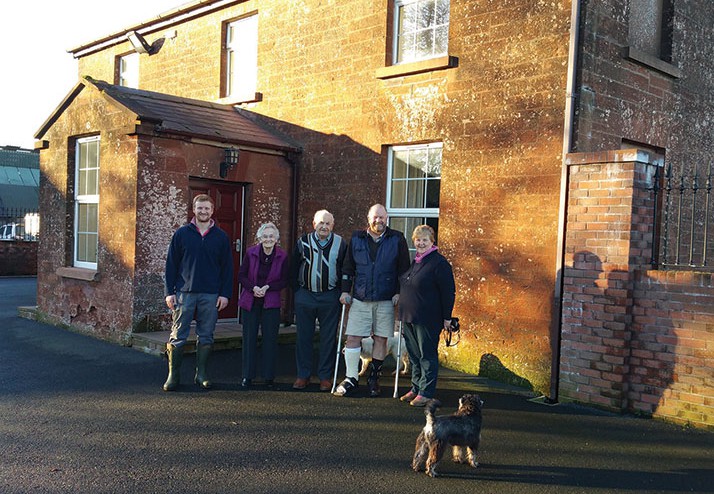
Every farmer strives to get the highest milk yield from their herd, but to achieve this, a lot of hard work; dedication and science must be applied.
Technology has become commonplace in the agricultural industry as revolutionary new machines have enhanced farming methods to give farmers every chance of reaching their ultimate goal, whether that be in dairy, beef, sheep, pigs, tillage or arable farming.
The new generation of farmers are not afraid of change and the work has certainly become more thought approached, than hands-on approached.
One family in Northern Ireland that is certainly willing to embrace science into their farming techniques are the Irwin’s (Redhouse Holsteins) who are located in the townland of Derrycreevy, near Benburb, Co Tyrone.
Father and son team of Alan and David have been running the farm for a number of years now. The Irwin family are dairy farmers who farm 240 acres of grass and cereals.
“A lot of the land that we have is too steep or wet for cutting silage, but we manage to cut about 120 acres over three cuts during the year,” said Alan.
“This is used to feed the 170 cows that we milk three times a day. We would also grow in the region of 50 acres of Spring Barley.”
Alan revealed that they have built the farm up over the years having suffered a massive setback in the early seventies.
“We lost the herd of cows to brucellosis back in 1974. It was another five years before the present herd started. Since then, we have not bought any stock, but have built the herd up to what it is today by breeding all our own replacements.”
No contractors are needed by the Irwin family as they carry out all work themselves with the help of two full time employees.
Alan revealed that their main aim was to increase the milk yield per cubicle and not the number of cows that they are milking.
“We’re happy enough with the size of the herd, but the big thing for us is to get the most out of each cow and increase their yield.”
To achieve this goal, technology and science comes more into play and this is where David comes to the fore.
“With the land we have, we can’t really expand the herd anymore, so the focus is on producing top genetic cattle that will produce high yields, whilst also focusing on health traits,” said David.
Redhouse Holsteins have already achieved part of their goal as they once had the highest yielding cow in Northern Ireland with a 305 day lactation of 24016L totalling 1537kg of solids.
David revealed that a number of factors have to be put in place to achieve this with the likes of feed, animal welfare and Genomics, which is an area within genetics that concerns the sequencing and analysis of an organism’s genome.
The genome is the entire DNA content that is present within one cell of an organism. Experts in genomics strive to determine complete DNA sequences and perform genetic mapping to help choose and breed replacement heifers with the best genetic potential. All heifers are now genotyped at Redhouse Holsteins.
“We have a nutritionist come in once a month to advise us on the correct TMR to give the cattle. They are fed on a home mixed ration with dry cows, and three groups of milking cows all on their own TMR, determined by yield.
“The amount of meal fed to cows is automatically changed daily depending on how much milk cows are producing, using in parlour feeders. The maximum change is 0.5kg per day so as to maintain optimal rumen health.
“The cows are split into three groups, pre/post calving, mid yielding and high yielding with the high yielding group being fed more meal accordingly.”
The process of drying off cows, hoof trimming and udder health, as well as optimal cow comfort, are all parts of animal welfare that are essential to help maintain this standard.
Right from birth, calves are placed in a process that will help them become the best cow possible.
“Calves are taken from the cow at birth and fed with a stomach tube straight away with 4-6L of colostrum so as not to introduce infection from the cow. The calf never sees the cow; this is for the welfare of the calf, as the mother is a reservoir of disease for an animal that is born with no immunity.”
David revealed that the calves are put on a special diet also from the first week of their lives, while they are kept in individual pens to avoid any potential diseases. We have a mortality rate of less than 1%.
“Our ultimate goal is to have all our cows reach 100 tonnes of milk. Whether we can manage that or not remains to be seen, but I’d be confident, with continued genetic selection and a good level of cow management and high standard of welfare, that we can.”
The Irwins are a self-sufficient family and in 2011 they erected their own wind turbine on the farm.
“The main purpose of this is to offset ever rising energy costs, and reduce the farms carbon footprint. Currently it is meeting these demands and has been a worthwhile investment. We have recently added a second turbine to the farm to further maximise energy savings.”
Redhouse Holsteins has captured the imagination of many farmers and both David and Alan welcome farmers to their farm to show them their facilities and procedures. These farm visits are organised through different organisations. For further information search Redhouse Holsteins on facebook and visit www.redhouseholsteins.com
David Irwin
Address:
51 Drumflugh Rd,
Benburb, Co. Tyrone, N. Ireland,
BT71 7QF
E: [email protected]
Phone: 02837 548799
Mobile: 07753856786
Taken from Irish Tractor & Agri magazine Vol 4 No 3, March 2016